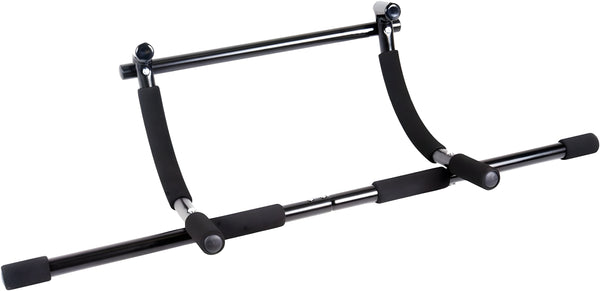Your Cart is Empty
June 30, 2023 3 min read
The pull up is a classic and challenging exercise that has been used for centuries to help build strength. It is an excellent way to develop back, shoulder, and arm muscles, as well as improve overall physical fitness. The pull up can be done with just your body weight or with additional weight added through various pieces of fitness equipment. Regardless of the level of fitness you are at, developing a pull up program can have lasting benefits.
Shop The Collection: Pull Up BarsIn this article, we’ll discuss how to create a pull up program from the perspective of professional fitness trainers. We’ll explore the different components of a pull up program, the benefits of pull ups, and advice for getting started on your pull up journey. By the end of this article, you will have all the knowledge you need to create an effective pull up program for yourself.
 Shop The Gear: CAP Barbell Xtreme Doorway Pull Up Bar, $27.99 USD
Shop The Gear: CAP Barbell Xtreme Doorway Pull Up Bar, $27.99 USD
A pull up program is an exercise and fitness regimen designed specifically for individuals who want to improve their ability to do pull ups. It typically consists of exercises that focus on strengthening the back, shoulders, arms, and core muscles. The goal of a pull up program is to gradually increase the number of reps one can do in each set. This can be accomplished by adding weight, increasing intensity, or varying the type of pull up exercises.
Pull ups have a variety of benefits. They are a great way to build muscle, strengthen the core, and increase overall physical fitness. Pull ups are also a functional exercise that can help with everyday movements like lifting, carrying, and pushing. Additionally, regular pull up exercises can lead to increased flexibility, improved posture, and better balance.
When creating a pull up program, it is important to consider the different components that make up the workout. These components include warm-ups, stretching, strength training, and cardio. Each component should be tailored to your individual needs and goals.
Before beginning any physical activity, it is important to warm up the body. Warming up prepares the body for exercise by increasing blood flow and raising body temperature. Warm-ups should include light aerobic activities such as jogging, walking, or jumping rope. This will help prevent injury and prepare the body for the intensity of the pull up program.
Stretching is an essential part of any fitness routine. It helps to reduce muscle tension, improve range of motion, and enhance flexibility. Before beginning any pull up exercises, it is important to stretch the major muscle groups involved in pull ups: the back, shoulders, arms, and core.
Strength training is an important part of any pull up program. Strength training helps build muscle, which is necessary for performing pull ups. Strength training exercises can include weighted pull ups, chin ups, lat pull downs, and rows. Sets and reps should be adjusted according to individual fitness levels. As fitness levels improve, weights can be increased.
Cardio exercises are also important for a pull up program. Cardio exercises help to increase endurance, burn calories, and improve overall cardiovascular health. Examples of cardio exercises include running, cycling, swimming, and rowing. Again, sets and reps should be adjusted according to individual fitness levels.
Now that you know the basic components of a pull up program, here are some tips to help you get started:
Creating a pull up program can be a great way to improve your physical fitness and build strength. With the right program and dedication, you can achieve amazing results. Remember to start slow, focus on form, and take rest days. With patience and persistence, you can conquer the pull up challenge!